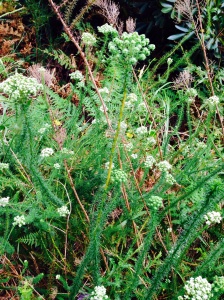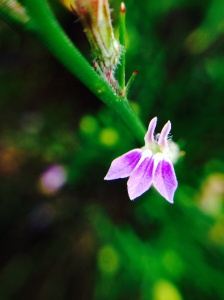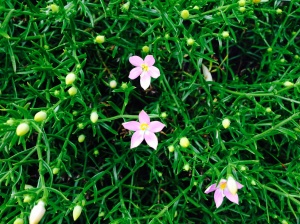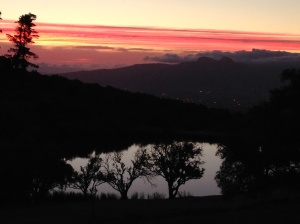On Friday evening the neighbours came to dinner and arrived early for a flower safari. Wonderful to have neighbours who love the mountain as much as we do and who appreciate how special it is. I took them on the old doctors road to see the waterfall which is pounding in its winter splendor. There are hundreds of flowers at this time of year, the wildflower spring commences long before flowers come to the garden. We discovered the old doctor’s road when Peter cleared a veritable forest of wattles along the river; they had overgrown this road and below it, a small but spectacular waterfall. Now this place is a haven for the fynbos which grew back the instant the trees were cleared.
From there we walked up to the weir, a favourite spot and much photographed for this blog because of the magic of the magnificent, ancient, white trunked Ilex Mitis trees, and then on up, above the weir and close to the top of the farm. The sun was setting behind the Paarderberg mountain; a soft mist gathered in the valley below, the evening was completely still, silent, breathless. The gentle warmth of a mild sunny winter’s day coming from the earth beneath our feet. As it grew darker the full dams in the valley gleamed the reflection of the evening sky into the stillness of the coming night. “It’s like a holy place” said Francois, “there’s something spiritual about it.”
Dinner was companionable, cheerful and as we are in wine tasting mode for Christopher’s wedding in January, a little too much drink was taken. Our guests left us late, very happy, as were we.
Perhaps a little less so the following morning when the full consequences of overindulgence emerged, but not enough to prevent me from donning the running clothes and setting off with the wolfhounds and Jemima Chew into the gloomy grey morning on a serious mission to photograph flowers for the blog. The first Babinia fragrens has appeared which is for me the harbinger of spring, and with it shrubs, little trees and tiny plants have burst into flower. I won’t post the Babinia, as there will be thousands more, I didn’t get a great photo and there is so much else to post. It rained heavily during the night, those very still evenings often indicate a change in weather and flowers were covered in raindrops. To my delight I’ve identified two new flowers that I don’t remember seeing last year and which turn out to be related. The first is Hermannia saccifera and the second is Hermannia hyssopifolia, a pretty and sizeable shrub with an unusual flower that has a pin-hole throat and this urn shaped body, called a calyx. Absolutely recognisable when I read the description, there is nothing quite like it.

Hermannia saccifera

Hermannia saccifera

Hermannia hyssopifolia
The Hermannia hyssopifolio grows in an area that Peter cleared last year, cutting through old fynbos and finding a large flat area where we least expected it, evidence of terracing by a farmer long ago. A stream runs through this area and shrubs and there is prolific growth along it’s banks, including this sprawling shrub with its sticky leaves and tar-like smell. It’s known as the tar pea, Bolusafra biuminosa, and grows, appropriately enough, along mountain streams.

Bolusafra bitumenosa, the tar pea
Another new identification also grows in this area, Phylica oleaefolia, with these pretty ranks of pale green, cupped flowers. This is quite a tall elegant shrub.

Philyca oleaefolia
We went down to an area where I haven’t been for a while and some of the yellow daisies are still flowering, the Athanasia trifurcata and the Osteospermum spinosum that I mentioned on a blog a couple of months ago. I love when the flower matches the book’s comments perfectly, particularly as the photos don’t always. The Athanasia trifucatum, says the book, has wedge shaped grey leaves, 3-5 toothed at the tips. If you look closely at the leaves in this photo you can clearly see the three teeth.

Osteospermum spinosum

Athanasia trifucatum
In the same place grows a tiny pelargonium, one of my favourite flowers which grows all year round in different parts of the farm. I think it’s Pelargonium myrrhifolium, var. myrrhifolium.

Pelargonium myrrhifolium varr. myrrhifolium
Along the road we walked on Friday night, which I call Erica Alley for the many varieties of Erica that make their home there, are several stunning varieties in flower. Two beautiful examples of the common Erica plukenetii, showing the range of colour, from white with very pale pink, to coral. And some with pretty pink bells in many shades, as well as this lovely white Erica where the bells grow in ranked series but which I have never identified.

Erica plunketii

Erica Plunketii

Erica with tiny pink bells

White Erica, with the flowers growing in orderly rows

A close up of the white Erica showing the tiny protruding anthers
Another pretty shrub which I have not managed to identify. The flowers are green and tiny; so tiny that a single raindrop captures several of them.
And a small tree-like shrub flowering in several places on the farm with prolific drooping flower heads, but I can’t find it in the book.

More familiar friends include Stachys aethiopica, also known as woundwort with it’s mint shaped leaves and pretty little pinky-white flowers.

Stachys aethiopica
All over the farm the buchu is in flower. Agthomsa, mostly crenulata, or a crenulata hybrid, though we also grow lots of Agthomsa betulina. Buchu, the common name, loves the sandy mountain soil and especially the north facing slopes on the farm. The flowers are mostly white but sometimes pretty shades of pink and lilac.

Agthomsa, or buchu with pink flowers
I couldn’t resist capturing Protea burchellii looking stunning in the grey morning light as well as the Leucadendron tinctum. These yellow flower heads will soon turn the most wonderful shade of coral – they are prolific on the mountain and grow in massed groups in certain areas.

Protea burchellii

Leucadendron tinctum
All in all we had a wonderful time, the dogs and I. As a run it wasn’t up to much but as a morning spent together on the mountain, it was the best of times. Maebh has boundless energy and was particularly happy to find a mongoose to chase. He is much much cleverer than she, there was never a chance of her catching him, but she was very pleased with her morning.

Maebh hunting in the olive groves, her coat dark from running in the soaking wet fynbos











































































































